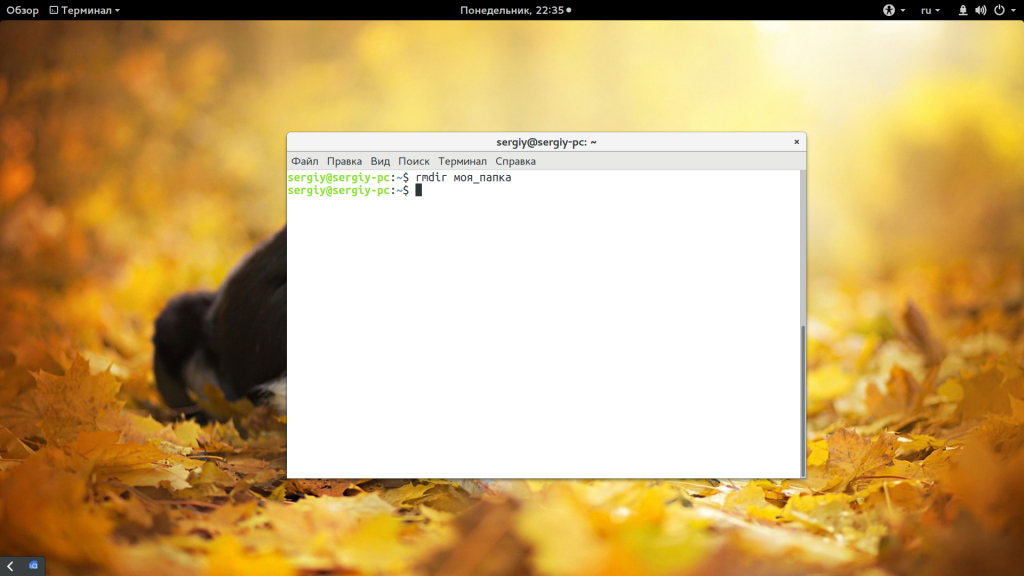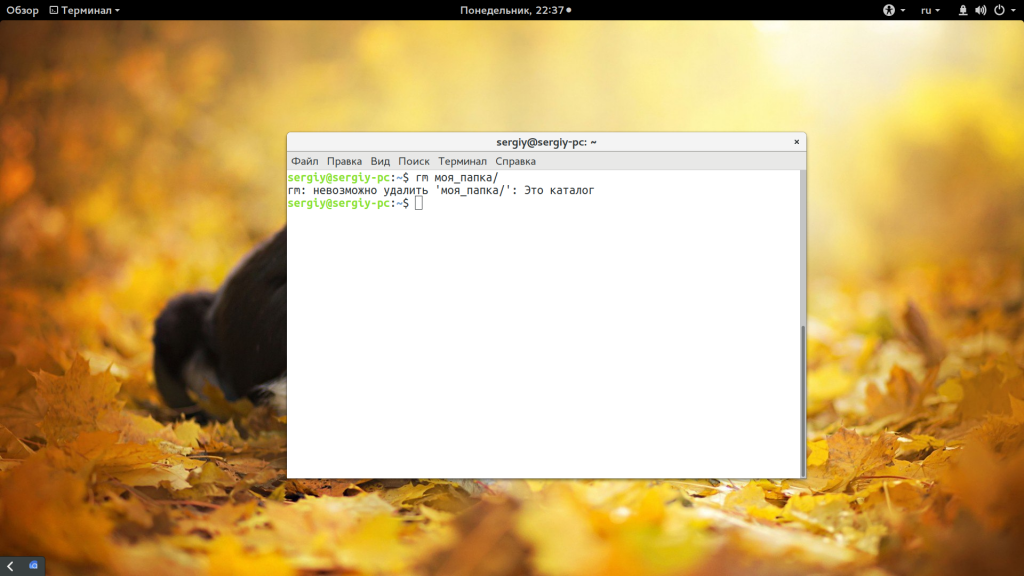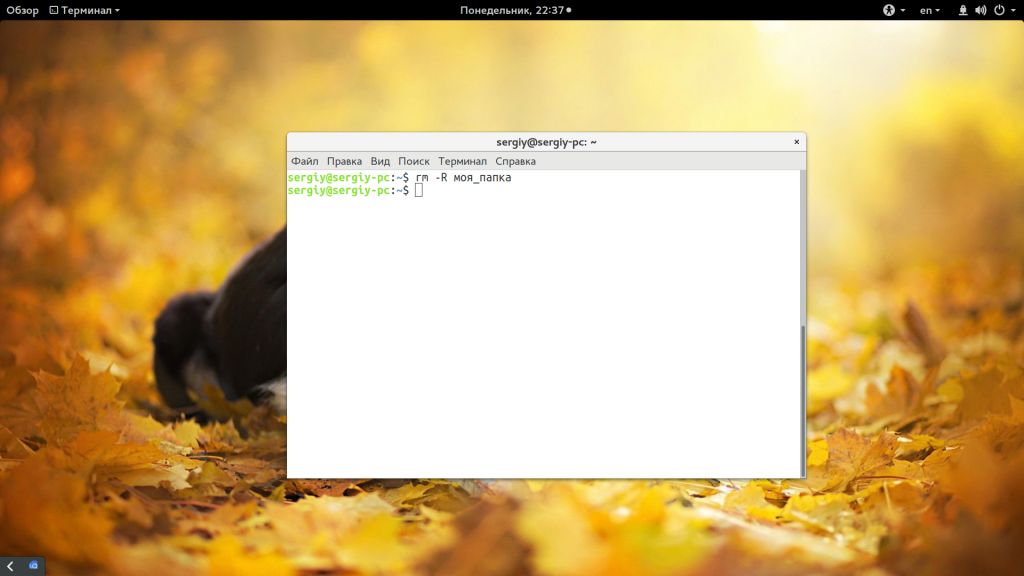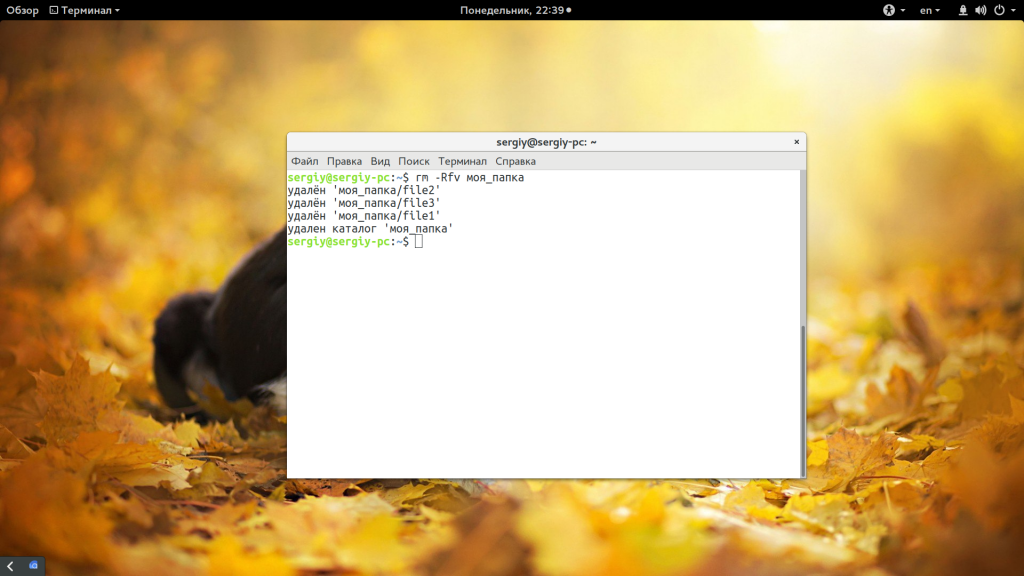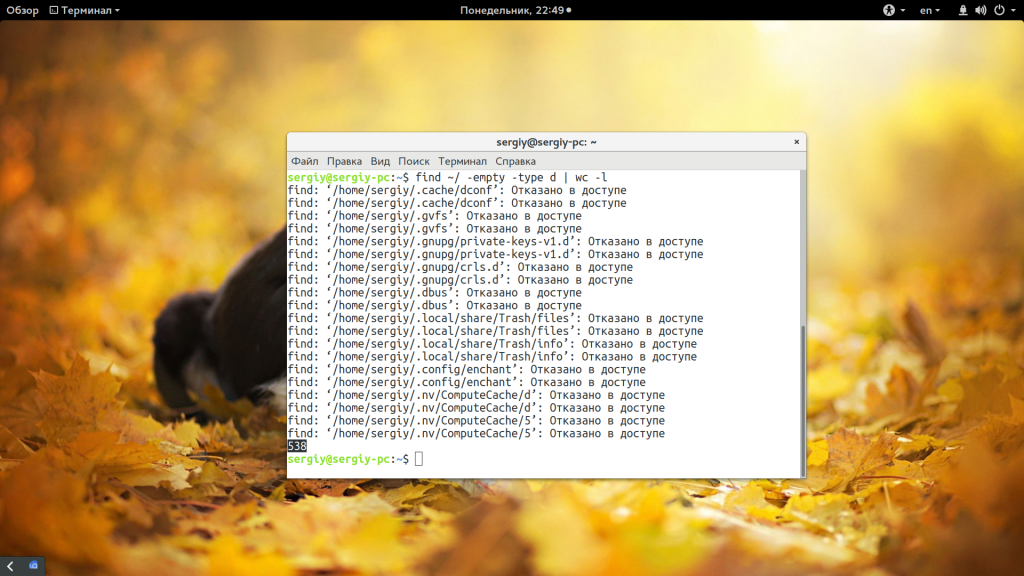- Delete / Remove a Directory Linux Command
- Commands to remove a directory in Linux
- rmdir command syntax to delete directory in Linux
- Delete directory Linux Command
- How to see a diagnostic message for every directory processed
- Removing directories with rmdir and wildcards
- Linux remove entire directory including all files and sub-directories command
- Are you getting permission denied error message while removing directories?
- Use find command to delete unwanted directories
- How to find and remove all empty directories
- Conclusion
- Как удалить каталог Linux
- Как удалить каталог Linux
- Выводы
- How to Delete a Directory in Linux
- Delete a directory using rmdir command
- Remove a directory using rm command
- Using find command
- Remove an empty directory
- Conclusion
Delete / Remove a Directory Linux Command
Commands to remove a directory in Linux
There are two command to delete a folder in Linux:
- rmdir command – Deletes the specified empty directories and folders in Linux.
- rm command – Delete the file including sub-directories. You can delete non-empty directories with rm command in Linux.
Let us see some examples and usage in details delete the directories.
rmdir command syntax to delete directory in Linux
The rmdir command remove the DIRECTORY(ies), if they are empty. The syntax is:
rmdir directory-name
rmdir [option] directory-name
Open the terminal application and run command to delete given directory. For example, delete a folder named dir1:
rmdir dir1
Delete directory Linux Command
Open a command line terminal (select Applications > Accessories > Terminal), and then type the following command to remove a directory called /tmp/docs:
rmdir /tmp/docs
If a directory is not empty you will get an error message that read as follows:
rmdir letters
Sample outputs:
You can cd to the directory to find out and list all files:
$ cd letters
$ ls
Delete those files or directories. In this next example, remove data, foo and bar if bar were empty, foo only contained bar and data only contained foo directories:
cd /home/nixcraft
rmdir -p data/foo/bar
Where,
- -p : Each directory argument is treated as a pathname of which all components will be removed, if they are empty, starting with the last most component.
How to see a diagnostic message for every directory processed
Pass the -v option to the rmdir command:
$ rmdir -v dir1
Sample outputs:
Removing directories with rmdir and wildcards
We can use wildcards such as ‘*’ and ‘?’ to match and delete multiple directories. For example:
$ ls -l dir*
We have three dirs named dir1, dir2, and dir3. To delete all directories starting with ‘dir’ in the current, you would use the following command:
rmdir -v dir*
Linux remove entire directory including all files and sub-directories command
To remove all directories and subdirectories use the rm command. For example, remove *.doc files and all sub-directories and files inside letters directory, type the following command:
Warning : All files including subdirectories will be deleted permanently when executed the following commands.
$ rm -rf letters/
Sample session:
Where,
- -r : Attempt to remove the file hierarchy rooted in each file argument i.e. recursively remove subdirectories and files from the specified directory.
- -f : Attempt to remove the files without prompting for confirmation, regardless of the file’s permissions
Are you getting permission denied error message while removing directories?
Only owners can delete their directories. However, a sysadmin can delete any directories created by anyone on the system. The syntax is:
sudo rmdir /path/to/dir/
sudo rm -rf dir2
When prompted, you need to provide root user or sudo user password.
Use find command to delete unwanted directories
Say you want to find out all directories named ‘session’ and delete them in the current directory, run:
find . -type d -iname ‘session’ -delete
- No ads and tracking
- In-depth guides for developers and sysadmins at Opensourceflare✨
- Join my Patreon to support independent content creators and start reading latest guides:
- How to set up Redis sentinel cluster on Ubuntu or Debian Linux
- How To Set Up SSH Keys With YubiKey as two-factor authentication (U2F/FIDO2)
- How to set up Mariadb Galera cluster on Ubuntu or Debian Linux
- A podman tutorial for beginners – part I (run Linux containers without Docker and in daemonless mode)
- How to protect Linux against rogue USB devices using USBGuard
Join Patreon ➔
How to find and remove all empty directories
Run:
find . -type d -iname ‘session’ -empty -delete
Where,
- -type d : Only search for directories and ignore all other files.
- -iname ‘session’ : Search directory named ‘session’. You can use wildcards here too. For example, -iname ‘dir*’ .
- -empty : Only match empty directories
- -delete : Deletes all found empty directories only
To delete all ‘.DS_store’ directories stored in /var/www/html, run:
sudo find /var/www/html/ -type d -name .DS_Store -exec rm <> \;
OR
sudo find /var/www/html/ -type d -name .DS_Store -exec rm <> +
The -exec option to the find command run an external command named rm to delete all files. The “ rm <> +/ ” is a better option as it uses one rm command to delete all .DS_Store directories.
Conclusion
This page showed how to delete a directory when it is empty. Further, it showed, how to remove folders using the rm and rmdir commands. See rm help page page for more info:
- For more information read man pages: rm(1)
🐧 Get the latest tutorials on Linux, Open Source & DevOps via
Источник
Как удалить каталог Linux
В операционной системе Linux можно выполнить большинство действий через терминал. Удаление каталога Linux — это достаточно простое действие, которое можно выполнить просто открыв файловый менеджер.
Однако в терминале это делается немного быстрее и вы получаете полный контроль над ситуацией. Например, можете выбрать только пустые папки или удалить несколько папок с одним названием. В этой статье мы рассмотрим как удалить каталог Linux через терминал.
Как удалить каталог Linux
Существует несколько команд, которые вы можете использовать для удаления каталога Linux. Рассмотрим их все более подробно. Самый очевидный вариант — это утилита rmdir. Но с помощью нее можно удалять только пустые папки:
Другая команда, которую можно применить — это rm. Она предназначена для удаления файлов Linux, но может использоваться и для папок если ей передать опцию рекурсивного удаления -r:
Такая команда уже позволяет удалить непустой каталог Linux. Но, можно по-другому, например, если вы хотите вывести информацию о файлах, которые удаляются:
rm -Rfv моя_папка
Команда -R включает рекурсивное удаление всех подпапок и файлов в них, -f — разрешает не удалять файлы без запроса, а -v показывает имена удаляемых файлов. В этих примерах я предполагаю что папка которую нужно удалить находится в текущей рабочей папке, например, домашней. Но это необязательно, вы можете указать полный путь к ней начиная от корня файловой системы:
rm -Rfv /var/www/public_html
Читайте подробнее про пути в файловой системе в статье путь к файлу Linux. Теперь вы знаете как удалить непустой каталог в консоли linux, далее усложним задачу, будем удалять папки, которые содержат определенные слова в своем имени:
find . -type d -name «моя_папка» -exec rm -rf <> \;
Подробнее про команду find смотрите в отдельной статье. Если кратко, то -type d указывает, что мы ищем только папки, а параметром -name задаем имя нужных папок. Затем с помощью параметра -exec мы выполняем команду удаления. Таким же образом можно удалить только пустые папки, например, в домашней папке:
/ -empty -type d -delete
Как видите, в find необязательно выполнять отдельную команду, утилита тоже умеет удалять. Вместо домашней папки, можно указать любой нужный вам путь:
find /var/www/public_html/ -empty -type d -delete
Перед удалением вы можете подсчитать количество пустых папок:
find /var/www/public_html/ -empty -type d | wc -l
Другой способ удалить папку linux с помощью find — использовать в дополнение утилиту xargs. Она позволяет подставить аргументы в нужное место. Например:
/ -type f -empty -print0 | xargs -0 -I <> /bin/rm «<>«
Опция -print0 выводит полный путь к найденному файлу в стандартный вывод, а затем мы передаем его команде xargs. Опция -0 указывает, что нужно считать символом завершения строки \0, а -I — что нужно использовать команду из стандартного ввода.
Если вы хотите полностью удалить папку Linux, так, чтобы ее невозможно было восстановить, то можно использовать утилиту wipe. Она не поставляется по умолчанию, но вы можете ее достаточно просто установить:
sudo apt install wipe
Теперь для удаления каталога Linux используйте такую команду:
Опция -r указывает, что нужно удалять рекурсивно все под папки, -f — включает автоматическое удаление, без запроса пользователя, а -i показывает прогресс удаления. Так вы можете удалить все файлы в папке linux без возможности их восстановления поскольку все место на диске где они были будет несколько раз затерто.
Выводы
В этой статье мы рассмотрели как удалить каталог linux, а также как удалить все файлы в папке linux без возможности их будущего восстановления. Как видите, это очень просто, достаточно набрать несколько команд в терминале. Если у вас остались вопросы, спрашивайте в комментариях!
Источник
How to Delete a Directory in Linux
Earlier in one of the tutorials, we have explained how to create directory in Linux. Now let’s check how to delete a directory in Linux which is either empty or having subdirectories with files. This is especially when you need to free up some space on your system in order to save more files or install additional packages.
There are many ways in which you can remove a directory in Linux. You can make use of the file manager if you are using a GUI system such as GNOME, MATE or KDE Plasma, or you can do it over the terminal.
When working with a GUI system deleting a directory takes it to the crash can, the equivalent of recycle bin in Windows from where it can be restored. However, the scenario is different when working on a command line on a minimal system because once a directory is deleted, it is permanently removed and cannot be recovered.
This tutorial will take you through various ways in which you can delete a directory in Linux.
Delete a directory using rmdir command
The rmdir command, short for’remove directory’, is a command-line tool that is used to delete empty directories. The operation will be successful if and only if the directory is empty. The syntax for deleting a directory is as follows:
For instance, to remove an empty directory called ‘mydirectory’, run the command:
If the directory is not empty, an error will be displayed on the screen as shown:
The error is a clear indication that the directory contains either files or folders or both.
Remove a directory using rm command
Short for remove, the rm command is used for deleting both empty and non-empty directories.
The rm command is usually used for removing files in Linux. However, you can pass some arguments that can help you delete directories. For example, to remove a directory recursively ( remove the directory alongside its contents), use the recursive option -r (-R or —recursive) as shown below.
If a directory is write-protected, you will be prompted whether to continue deleting the files inside the directory and the directory as a whole. To save you the annoyance and inconvenience of constantly bumping into such prompts, add the -f option to force the deletion without being prompted.
Additionally, you can delete multiple directories at a go in a single command as shown in the command below. The command deletes all the directories and their subdirectories without prompting for deletion.
To exercise more caution, you can use the -i option which prompts for the deletion of the directories and subdirectories. However, as we saw earlier, this can be quite annoying especially if you have several subfolders and files. To address this inconvenience, use the -I flag to prompt you only once.
When you hit y for ‘Yes’, the command will remove all the subfolders and files in the directory without prompting any further.
To remove an empty directory, pass the -d option as shown below.
Using find command
Find command is a command-line tool that helps users search for files as well as directories based on specific search criteria/pattern or expression. Additionally, the command can be used to search for directories and delete them based on the specified search criteria.
For example, to delete a directory called ‘mydirectory’ in the current directory, run the command below.
Let’s break down the parameters in the command
( . ) — This denotes the directory in which the search operation is being carried out. If you want to carry out the search in your current directory use the period sign (.)
-type d — This sets the search operation to search for directories only.
-name — This specifies the name of the directory.
-exec rm -rf — This deletes all directories and their contents.
<> +- — This appends all the files found at the end of the rm command.
Let’s take another example:
Remove an empty directory
If you wish to remove all empty directories use the following command:
Again, let’s break this down
. — This recursively searches in the current working directory
-type d — This keeps the search to directories only
-empty — This restricts the search pattern to empty directories only
-delete — This will delete all the empty directories found including subdirectories.
If you have lots of empty directories then use a shell script to delete empty directory.
Conclusion
In this tutorial, we looked at how to delete a directory in Linux using the rm, rmdir and find commands. We hope you can comfortably delete a directory in Linux whether it contains files and other subdirectories, or simply if it is empty. Give it a try and get back to us with your feedback.
Источник
